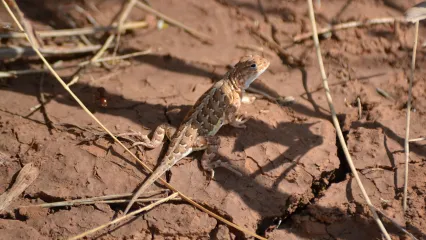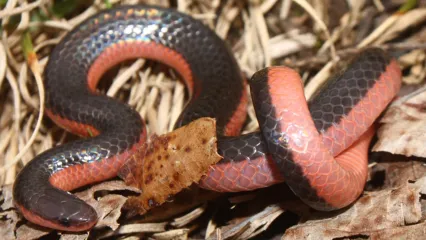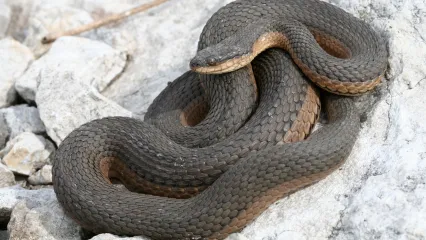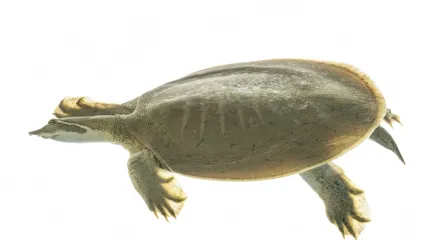
Description
Lesser earless lizards are relatively small, stout-bodied diurnal lizards with small granular scales on the body. They can easily be distinguished from all lizards in Oklahoma by the absence of an ear opening (hence the name “earless”). Only one other lizard species in the United States lacks an ear opening, the greater earless lizard (Cophosaurus texanus) and it does not occur in Oklahoma. In addition, lesser earless lizards have two folds of skin across the throat. Coloration is gray with a double row of chevron-like markings on the back, which fade out completely on the base of the tail. The belly is white. Two black bars appear along the outer edge of the belly on both sides, and on males, these bars are surrounded by blue, which intensifies during the breeding season. In some females, the dark bars are reduced or absent. The only similar lizard in Oklahoma is the prairie lizard, which has keeled dorsal scales and ear openings.
Size
Adult lesser earless lizards average about 2.5 inches in snout to vent length, with males slightly larger (3 inches) than females (2.5 inches or less). The tail is relatively short, usually not exceeding the length of the body.
Habitat
In North America, the distribution of lesser earless lizards extends west to east from central Arizona to central Oklahoma and north to south from southern Nebraska into Mexico.
Life Cycle
Lesser earless lizards are morphologically and behaviorally adapted to live in areas with sandy or soft, pliable soils. They easily bury themselves when inactive. When active on the surface, their disruptive pattern and coloration render them highly cryptic against the ground. They are most easily detected when they move, but when they stop they again are difficult to see. Breeding occurs during spring and early summer. Male coloration, particularly the blue surrounding the dark bars along mid-body, is enhanced during the breeding season, and females develop orange coloration along the sides of their bodies when ovulating eggs. Clutch size varies considerably from two to as many as seven or more eggs. Larger females produce the largest clutches. Eggs are deposited in soft humid soils and hatch from late July through August and early September. Although a wide variety of insects and spiders are eaten, grasshoppers and true bugs comprise most of the diet. Small lizards are occasionally eaten as well.
How To Observe
Because these lizards are very cryptically colored and tend to not move until approached, they can be difficult to observe. By walking through sandy areas and watching for movement on the ground, it is possible to observe these lizards when they are active. Late morning tends to be best.
(This profile was created by Dr. Laurie Vitt as part of a partnership between the Wildlife Department and the Sam Noble Oklahoma Museum of Natural History. It was funded as part of a larger State Wildlife Grant to survey and inventory amphibians and reptiles of the Wildlife Management Areas of Oklahoma: T-35-P-1.)


